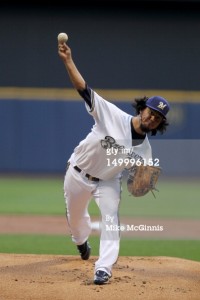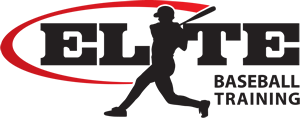By Travis Kerber – Head Instructor, Elite Baseball Training
One of the first memories I have about throwing is from when I was in Little League and my coach use to always say, “Throw over the top”. The other throwing cue that I remember hearing from coaches was, “Don’t throw sidearm, it’s bad for you”. When you’re a kid you never ask a coach for clarification, you do what they tell you, because they are the people who teach us our favorite game. When there is no explanation we take things literally. The next throws we make feel awkward because we are trying to get our hand as high above our head as possible. We keep doing it because that is what we are told to do. Over time it just becomes the way we throw. This idea is clarified below.
 In the photo on the left we see Milwaukee Brewer pitcher Yovani Gallardo delivering a pitch to home plate. This is what coaches would consider as “over the top”. His hand appears to be several feet higher than his head at release, but upon closer examination his hand is virtually even with his ear at release. What you see is a trick of the eye because his shoulders are tilted towards his glove side. To see this picture clearly use your hand to cover every part of his body below his shoulders. If you tilt your head to the same angle as his shoulders with his body still covered up you will see his hand at it’s true release point even with his ear. After taking your hand off the picture you will most likely start to notice that his head is considerably outside his landing leg as he releases. The angle from his throwing shoulder to his throwing elbow to his throwing wrist is approximately 165 degrees. As we all know, 180 degrees is straight. This means he is almost throwing completely sidearm from a higher shoulder tilt. As you look down at the second image of Yovani Gallardo you will see him throwing out a runner at first base. In this picture you will notice that he has the same 165 degree arm angle, but because the tilt of his shoulders is considerably less than the first picture you can see his hand is slightly above his ear at release. In fact with full rotation his arm angle will be 165 degrees no matter how little or much shoulder tilt he has. This is his natural arm angle. The second picture is typically classified as “sidearm”, yet it is the same angle as the first.
In the photo on the left we see Milwaukee Brewer pitcher Yovani Gallardo delivering a pitch to home plate. This is what coaches would consider as “over the top”. His hand appears to be several feet higher than his head at release, but upon closer examination his hand is virtually even with his ear at release. What you see is a trick of the eye because his shoulders are tilted towards his glove side. To see this picture clearly use your hand to cover every part of his body below his shoulders. If you tilt your head to the same angle as his shoulders with his body still covered up you will see his hand at it’s true release point even with his ear. After taking your hand off the picture you will most likely start to notice that his head is considerably outside his landing leg as he releases. The angle from his throwing shoulder to his throwing elbow to his throwing wrist is approximately 165 degrees. As we all know, 180 degrees is straight. This means he is almost throwing completely sidearm from a higher shoulder tilt. As you look down at the second image of Yovani Gallardo you will see him throwing out a runner at first base. In this picture you will notice that he has the same 165 degree arm angle, but because the tilt of his shoulders is considerably less than the first picture you can see his hand is slightly above his ear at release. In fact with full rotation his arm angle will be 165 degrees no matter how little or much shoulder tilt he has. This is his natural arm angle. The second picture is typically classified as “sidearm”, yet it is the same angle as the first.
 To better understand this lets get into the physics of it. The body creates an extremely fast rotation upon a center point as we throw. The force this creates is centripetal. Centripetal force causes our arm to follow the same arc that our body takes as we rotate. Simply put, if you open the washing machine all the clothes have been thrown against the outside because the cylinder rotates around a central axis. Your shoulder, elbow, and wrist all follow the same turn as your body so your hand cannot physically stay close to the body. The only way your hand can stay close to your center point is if you rotate at a slower rate. In a study of 70 current and former big leaguers the biggest arm angle was 154 degrees.
To better understand this lets get into the physics of it. The body creates an extremely fast rotation upon a center point as we throw. The force this creates is centripetal. Centripetal force causes our arm to follow the same arc that our body takes as we rotate. Simply put, if you open the washing machine all the clothes have been thrown against the outside because the cylinder rotates around a central axis. Your shoulder, elbow, and wrist all follow the same turn as your body so your hand cannot physically stay close to the body. The only way your hand can stay close to your center point is if you rotate at a slower rate. In a study of 70 current and former big leaguers the biggest arm angle was 154 degrees.
The most efficient delivery would be shoulders parallel with the ground, which would equate to all pitchers being considered “sidearmers”. A couple points need to be explained here. This would be a safe “sidearm” throwing action and would create less stress in the shoulder and elbow. Yet there is also an unsafe sidearm that is generally caused by poor sequencing or low wrist elbow relationship at foot down.
The advantages of tilting your shoulders to the glove side are limited, but in some cases beneficial. To throw a “12-6” curve ball you need to be able to get your fingers on top of the ball so they come directly in front of the ball at release. The only way to get your fingers on top of the ball is to tilt your shoulders to the glove side. The other advantage of this would be the ability to create more tilt to your fastball.
The disadvantages, in my opinion, far out weigh the advantages. The first disadvantage is the most important, and that is safety. To create this tilt you must change posture to the glove side. When changing posture you will force energy down and outside the landing leg. This forces the throwing arm to act in an equal but opposite direction. This means the arm will work up and and away from the intended target. The resulting action forces the athlete to pull their arm back into the intended direction. This will put more undo stress on either the shoulder or elbow. The second disadvantage is the limited ability to create consistent control. Because the athlete is forced to pull their arm away from natural centripetal force it will result in an inconsistent release point. The top athletes are more able to be successful at this than typical athletes.
So before you tell your pitchers to “throw over the top” or not “sidearm” consider that you are more likely to get injured by tilting your shoulders, and the only way to get “over the top” is to tilt your shoulders. If you know a coach/parent please pass this on so we can continue to increase efficiency and decrease injury. See additional photos below of Mark Mulder on a pitch and throw to first. Same arm angle, different tilt. 

Travis Kerber is the head instructor at Elite Baseball Training. He is available for lessons at Bash Sports Academy in Chicago, Perfect Swing in Darien, and Triple Crown All Stars in Northwest Indiana. To book lessons with Travis, you can book online at elitebaseballtraining.com or by calling 773-682-5549.
Tags: baseball, Bash Sports Academy, brewers, chicago, Darien, elbow, elite, elitebaseballtraining.com, fastball, injury, Justin Stone, lessons, Mark Mulder, over the top, Perfect Swing, pitching, shoulder, sidearm, throwing, tips, Travis Kerber, Triple Crown All Stars, velocity, yovani gallardo







